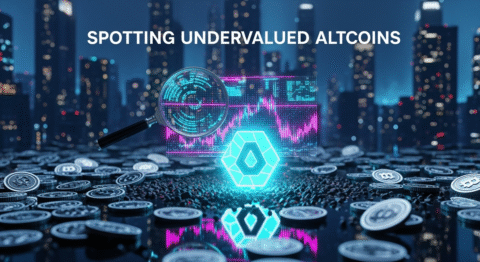Have you ever wondered why some obscure digital tokens skyrocket in value overnight, only to plummet just as quickly, leaving many investors holding the bag? In the dynamic world of cryptocurrency, understanding these dramatic price surges – specifically, how to spot Crypto Bubbles – is the key to navigating the wild west of altcoins and meme coins
The Core Concept: How Crypto Bubbles Actually Work
At its heart, a market bubble is a period of excessive speculation where asset prices rise far beyond their intrinsic value, driven by optimism and often fueled by FOMO (Fear Of Missing Out). In the crypto space, these bubbles are particularly pronounced due to the market’s nascency, speculative nature, and the accessibility of digital assets to a global audience. Crypto Bubbles can form around various digital assets, but they are most commonly observed with altcoins and meme coins, which often lack the established utility or track record of more mature cryptocurrencies.
What Are Altcoins / Meme Coins / Airdrops?
Altcoins, short for “alternative coins,” are any cryptocurrencies other than Bitcoin. They emerged as developers sought to improve upon Bitcoin’s perceived limitations or explore new use cases for blockchain technology. Altcoins encompass a vast spectrum, from established projects like Ethereum, which powers decentralized applications (dApps) and smart contracts, to newer, more niche tokens focused on areas like supply chain management, gaming, or privacy.
Meme coins, on the other hand, are a more recent phenomenon. Often created as a joke or inspired by internet memes and social media trends, they typically start with little to no underlying utility. Their value is primarily driven by community sentiment, social media engagement, and speculative trading. Dogecoin and Shiba Inu are prime examples, initially conceived as parodies but later gaining significant market capitalization due to widespread online popularity and endorsement from influential figures.
Airdrops, while not a type of coin themselves, are a marketing strategy used by new crypto projects to distribute tokens freely to a wide audience. This is typically done to raise awareness, encourage adoption, or reward existing holders of another cryptocurrency. While airdrops can be a way to acquire new tokens for free, they can also be a front for scams or a prelude to a pump-and-dump scheme if not approached with caution.
Key Components & Technologies
The technology underpinning cryptocurrencies is foundational to their function and potential. While Bitcoin operates on a Proof-of-Work (PoW) consensus mechanism, many altcoins have adopted more energy-efficient and scalable alternatives like Proof-of-Stake (PoS), Delegated Proof-of-Stake (DPoS), or hybrid models.
Blockchain Technology: This distributed ledger technology is the backbone of most cryptocurrencies. It allows for secure, transparent, and immutable record-keeping of transactions. The efficiency and scalability of a particular blockchain can significantly impact the performance and adoption of the altcoins built on it.
Smart Contracts: Pioneered by Ethereum, smart contracts are self-executing contracts with the terms of the agreement directly written into code. They enable decentralized applications (dApps), decentralized finance (DeFi) protocols, Non-Fungible Tokens (NFTs), and a host of other innovative use cases for altcoins.
Tokenomics: This refers to the economic model of a cryptocurrency. It encompasses aspects like total supply, circulating supply, distribution mechanisms (e.g., mining, staking, ICOs), burning mechanisms, and utility within its ecosystem. Well-designed tokenomics can foster long-term value, while poor tokenomics can be a red flag for potential Crypto Bubbles.

The Data-Driven Perspective
To truly understand and identify Crypto Bubbles, we must look beyond the hype and delve into the data. The cryptocurrency market provides a wealth of information for those willing to analyze it.
Market Data & Trends
Analyzing historical price charts, trading volumes, and market capitalization data for altcoins and meme coins is a critical first step. We can observe patterns that often precede a significant price surge and subsequent crash. For instance, a sudden, parabolic increase in price accompanied by an equally sharp and inexplicable spike in trading volume can be indicative of a coordinated pump.
Consider the following data points when assessing a potential meme coin pump:
- Volume Spikes: An unusual surge in trading volume, especially without significant news or development announcements, is a strong indicator.
- Social Media Buzz: While organic community growth is healthy, an overwhelming and sudden increase in mentions and sentiment across platforms like Twitter, Reddit, and Telegram, often driven by paid influencers, can signal a coordinated pump.
- Price Action: A steep, near-vertical price increase, especially after a prolonged period of low activity, is a classic bubble characteristic.
- Market Cap: While meme coins often start with low market caps, a rapid ascent to hundreds of millions or billions in market cap in a short period, without substantial underlying development, is often unsustainable.
Platforms like CoinMarketCap, CoinGecko, and blockchain explorers provide invaluable raw data. Looking at the trend of daily active users, transaction counts, and developer activity for altcoins can offer insights into their actual utility and adoption. A project with a steadily growing user base and active development is less likely to be a pure pump-and-dump compared to one whose price is solely driven by social media chatter.
Tokenomics & Market Health
The tokenomics of a cryptocurrency are crucial for understanding its long-term viability and susceptibility to speculative bubbles.
- Total Supply & Distribution: Does a single entity or a small group hold a disproportionately large percentage of the tokens? If so, they could manipulate the price, creating a bubble and then cashing out. Early investors or the development team holding a large chunk of tokens can be a significant risk.
- Utility: Does the token have a real-world use case or provide value within its ecosystem? Altcoins aiming to solve specific problems or enhance existing technologies generally have more sustainable value propositions. Meme coins, by their nature, often lack this.
- Inflation/Deflation: Is the token supply fixed, increasing (inflationary), or decreasing (deflationary)? High inflation rates without corresponding utility can devalue the token over time. Deflationary mechanisms (like token burning) can sometimes artificially inflate prices if demand doesn’t keep pace.
- Liquidity: Is there sufficient liquidity on exchanges? Thin markets are more susceptible to price manipulation and can exacerbate volatility.
For instance, an altcoin whose tokenomics are designed for a fast launch with a large initial supply distributed to the team and early investors, with little focus on community staking or network usage, is a prime candidate for a pump-and-dump cycle. Conversely, a project with a well-defined vesting schedule for its team, a clear roadmap for utility, and a gradual release of tokens to the market is generally considered more robust. Analyzing the trading volume relative to the market cap can also reveal if a significant portion of the price action is driven by genuine interest or speculative trading. A high price with low trading volume might indicate a lack of robust market interest and a higher risk of a swift price correction.
Risks, Challenges & Competition
Participating in the altcoin and meme coin markets, while potentially rewarding, comes with significant risks.
Risks of Altcoins and Meme Coins
- Extreme Volatility: The prices of altcoins and meme coins can fluctuate wildly, often experiencing double-digit percentage swings within hours. This makes them unsuitable for risk-averse investors.
- Security Vulnerabilities: Newer projects may have unproven technology or smart contract code that could be exploited by hackers, leading to loss of funds.
- Regulatory Uncertainty: The regulatory landscape for cryptocurrencies is still evolving. New regulations could impact the usability, trading, or even the legality of certain altcoins or meme coins.
- Scams and Fraud: The allure of quick riches attracts scammers. Pump-and-dump schemes are rampant, where coordinated groups artificially inflate the price of a low-volume coin before selling their holdings, leaving later buyers with worthless assets. Rug pulls, where developers abandon a project and abscond with investor funds, are also common, especially in the meme coin space.
- Lack of Intrinsic Value: Many meme coins and some speculative altcoins lack tangible utility or a strong development team, meaning their value is purely based on speculation and hype, making them susceptible to sudden crashes when the sentiment changes.
How Does a Speculative Cryptocurrency Stack Up Against Its Competitors?
To illustrate, let’s consider a hypothetical altcoin focused on decentralized gaming versus a popular meme coin.
| Feature | Hypothetical Gaming Altcoin | Popular Meme Coin (e.g., inspired by Dog) | Competitors |
|---|---|---|---|
| Primary Goal | Powering a decentralized gaming ecosystem. | Community, memes, speculative investment. | Other gaming tokens, blockchain platforms; Established meme coins. |
| Utility | In-game purchases, governance, staking rewards. | Primarily speculative trading, community engagement. | DeFi tokens, utility tokens, platform tokens; other meme coins. |
| Technology | Robust blockchain, smart contracts for game logic. | Basic blockchain, often less advanced. | Ethereum, Solana, Polygon, other gaming blockchains. |
| Tokenomics | Inflation control, utility-driven demand, vesting. | Often inflationary, high initial supply. | Varies greatly; focus on sustainable supply and demand dynamics. |
| Development | Active development team, clear roadmap, audits. | Community-driven, sometimes less structured development. | Professional development teams, established project roadmaps. |
| Risk Profile | Moderate to High (tech risk, market adoption). | Very High (speculative, sentiment-driven). | Varies; Market cap, team, utility, and adoption are key indicators. |
| Bubble Risk | Moderate (influenced by market sentiment & adoption). | High (heavily reliant on hype & FOMO). | Higher for projects lacking fundamental value or strong community backing. |
This comparison highlights how a project with a clear utility and robust development is inherently different from one driven primarily by social trends. While both can experience Crypto Bubbles, the underlying foundations dictate their potential for long-term stability.
The Future Outlook
What’s Next for Altcoins / Meme Coins / Airdrops?
The future of altcoins and meme coins is intrinsically linked to the broader evolution of the cryptocurrency and blockchain industries.
For Altcoins, the trend is likely towards greater specialization and integration. We’ll probably see continued innovation in areas like:
- Scalability Solutions: Layer-2 solutions and more efficient blockchain architectures will become increasingly important for widespread adoption.
- Interoperability: Projects that can connect different blockchains and facilitate seamless asset transfer will gain prominence.
- Real-World Use Cases: Altcoins with tangible applications in finance (DeFi), supply chain, gaming, digital identity, and sustainability will likely see more sustainable growth.
- Regulation: As the market matures, regulatory clarity will be crucial. Projects that are compliant and transparent will be better positioned for long-term success.
Meme Coins will likely remain a volatile but popular segment, driven by internet culture and community. Their future is less tied to innovation and more to their ability to capture and maintain cultural relevance. While some may fade into obscurity, others could evolve to incorporate limited utility or become deflationary, attempting to build more sustainable value. The risk of Crypto Bubbles in this space will persist, as their valuation is inherently tied to sentiment.
Airdrops will continue to be a marketing tool, but their effectiveness will depend on the quality and legitimacy of the projects offering them. Sophisticated investors are becoming more discerning, looking for airdrops from projects with solid fundamentals rather than purely speculative ventures.
Conclusion
Navigating the cryptocurrency market requires a keen understanding of not just the potential upside, but also the inherent risks. While Crypto Bubbles can offer rapid gains, they often lead to significant losses if not approached with caution and a data-driven mindset. By understanding what drives their formation, analyzing tokenomics, monitoring market data, and being aware of the risks associated with altcoins and meme coins, you can make more informed investment decisions.
Remember, thorough research (DYOR – Do Your Own Research) is paramount. Never invest more than you can afford to lose, and diversify your portfolio to mitigate risk.
What are your experiences with altcoin and meme coin pumps? Have you successfully navigated a meme coin pump or fallen victim to a crypto bubble? Share your thoughts and strategies in the comments below! Stay tuned for more in-depth analysis on navigating the exciting world of digital assets.
FAQs
Q1: What is the most significant sign of a potential crypto bubble?
A1: A rapid, parabolic price increase coinciding with a massive surge in trading volume and intense social media hype, particularly when lacking underlying fundamental development or a clear use case, is a strong indicator of a potential Crypto Bubble.
Q2: How can I differentiate between a legitimate altcoin project and a pump-and-dump scheme?
A2: Legitimate altcoins typically have active development teams, a clear roadmap, audits for their smart contracts, a sustainable tokenomics model designed for utility, and a growing community that engages with the project’s purpose. Pump-and-dump schemes often lack these fundamentals, relying solely on hype and coordinated buying/selling to inflate prices.
Q3: Are meme coins inherently bad investments?
A3: Meme coins are highly speculative and carry significant risk. Their value is primarily driven by sentiment and community, making them prone to extreme volatility and Crypto Bubbles. While some may offer short-term gains, they are not typically considered sound long-term investments due to their lack of intrinsic utility for most.
Q4: What is a “rug pull” in the crypto context?
A4: A rug pull is a type of scam where developers in a cryptocurrency project, typically a new altcoin or meme coin, abandon the project after attracting investment, taking away all the investors’ liquidity. This often happens when the developers have a large percentage of the token supply and sell it off suddenly, crashing the price and disappearing with the funds.
Q5: How important is community in meme coin success?
A5: Community is absolutely critical for meme coin success. The collective enthusiasm, social media presence, and buying pressure from a strong community are what often drive the price of meme coins, making them susceptible to organized pumps and the formation of spectacular Crypto Bubbles.






